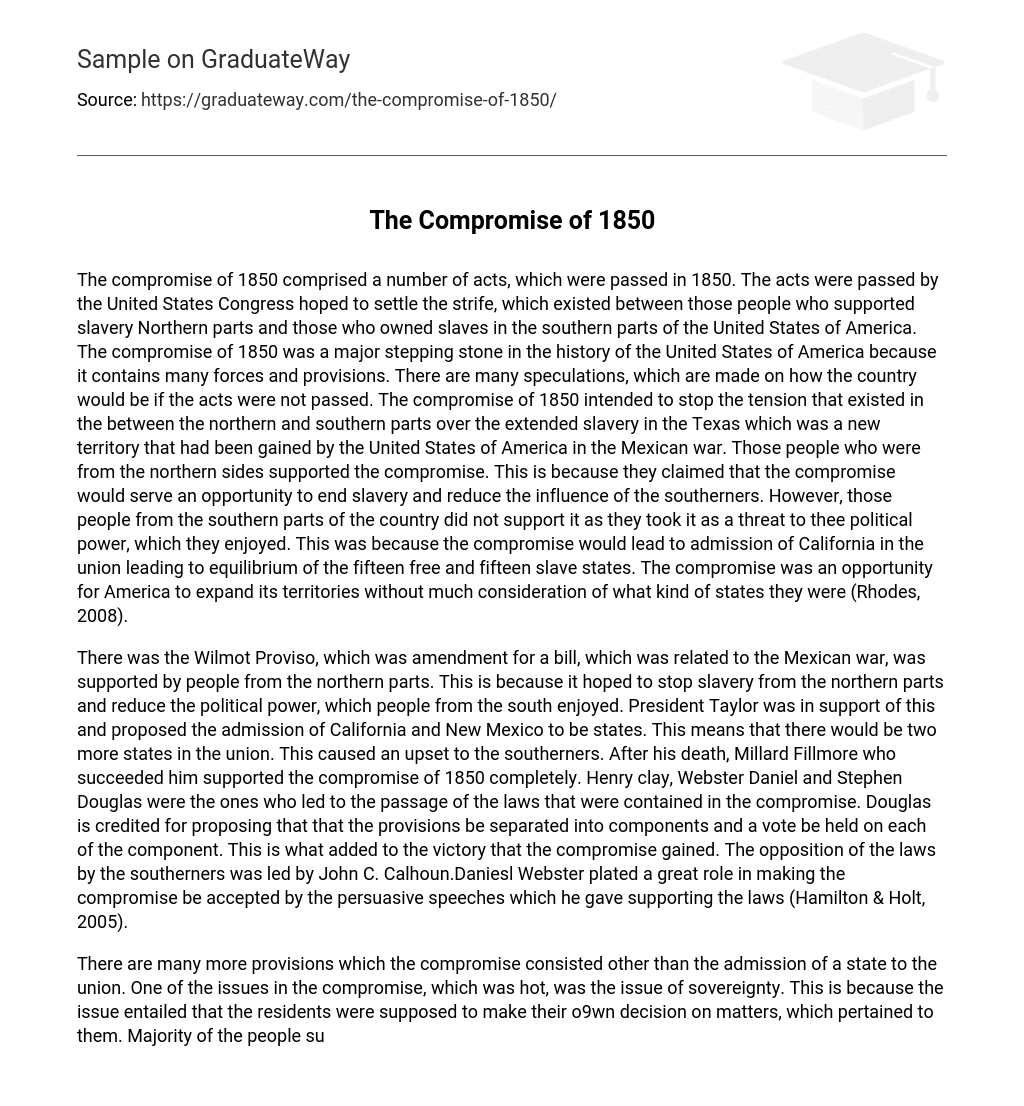The compromise of 1850 comprised a number of acts, which were passed in 1850. The acts were passed by the United States Congress hoped to settle the strife, which existed between those people who supported slavery Northern parts and those who owned slaves in the southern parts of the United States of America. The compromise of 1850 was a major stepping stone in the history of the United States of America because it contains many forces and provisions. There are many speculations, which are made on how the country would be if the acts were not passed. The compromise of 1850 intended to stop the tension that existed in the between the northern and southern parts over the extended slavery in the Texas which was a new territory that had been gained by the United States of America in the Mexican war. Those people who were from the northern sides supported the compromise. This is because they claimed that the compromise would serve an opportunity to end slavery and reduce the influence of the southerners. However, those people from the southern parts of the country did not support it as they took it as a threat to thee political power, which they enjoyed. This was because the compromise would lead to admission of California in the union leading to equilibrium of the fifteen free and fifteen slave states. The compromise was an opportunity for America to expand its territories without much consideration of what kind of states they were (Rhodes, 2008).
There was the Wilmot Proviso, which was amendment for a bill, which was related to the Mexican war, was supported by people from the northern parts. This is because it hoped to stop slavery from the northern parts and reduce the political power, which people from the south enjoyed. President Taylor was in support of this and proposed the admission of California and New Mexico to be states. This means that there would be two more states in the union. This caused an upset to the southerners. After his death, Millard Fillmore who succeeded him supported the compromise of 1850 completely. Henry clay, Webster Daniel and Stephen Douglas were the ones who led to the passage of the laws that were contained in the compromise. Douglas is credited for proposing that that the provisions be separated into components and a vote be held on each of the component. This is what added to the victory that the compromise gained. The opposition of the laws by the southerners was led by John C. Calhoun.Daniesl Webster plated a great role in making the compromise be accepted by the persuasive speeches which he gave supporting the laws (Hamilton & Holt, 2005).
There are many more provisions which the compromise consisted other than the admission of a state to the union. One of the issues in the compromise, which was hot, was the issue of sovereignty. This is because the issue entailed that the residents were supposed to make their o9wn decision on matters, which pertained to them. Majority of the people supported the idea that the government was supposed to allow the residents of New Mexico and Utah make decisions for themselves whether they wanted to be a free state or a slave state. The other issue was of major concern in the compromise was the fugitive slave act which was urged by Clay. The acts stated that those who owned slaves had the right to capture and make those slaves who had fled to territory. However, the majority felt that the act was not of any help because it would be difficult for many of the slaveholders to incur the cost of a run away slave. The most controversial issue and the most important topic of the compromise of 1850 was whether California would be allowed to join the union of the free states, slave state or whether the decision was supposed to be decided by the popular sovereignty. The provisions were separated into separate votes, which made it possible for the majority to be for the compromise. Then it was signed as law by President Fillmore in 1850 (Waugh, 2003).
Another aspect of compromise of 1850 was the provision of fugitive slave law, which was stringer. The compromise made it illegal not to return a slave who had run away to the south. It also provided that a suspected run away slave would be tried by one judge but not by jury. There was away that the judges were compensated more money by making a decision that a slave was guilty. Therefore, this law acted as one way of discouraging people from harboring slaves. However, the compromise of 1850 was not just a debate, which ensued between, the North and the South but focused more over expansion and touched the issue of slavery. This compromise acted as a test of the strength of the United States of America. It showed that no matter what the circumstances it is possible for a goal to be attained by a common man if there is the desire and persistence (Rhodes, 2008).
References
Hamilton, H. & Holt, M. (2005) Prologue to conflict: the crisis and compromise of 1850, Kentucky, University Press of Kentucky.
Rhodes, J. (2008) History of the United States from the Compromise of 1850, Volume 1, New York, BiblioBazaar, LLC.
Waugh, J. (2003) On the brink of Civil War: the Compromise of 1850 and how it changed the course of American history, USA, Rowman & Littlefield.





